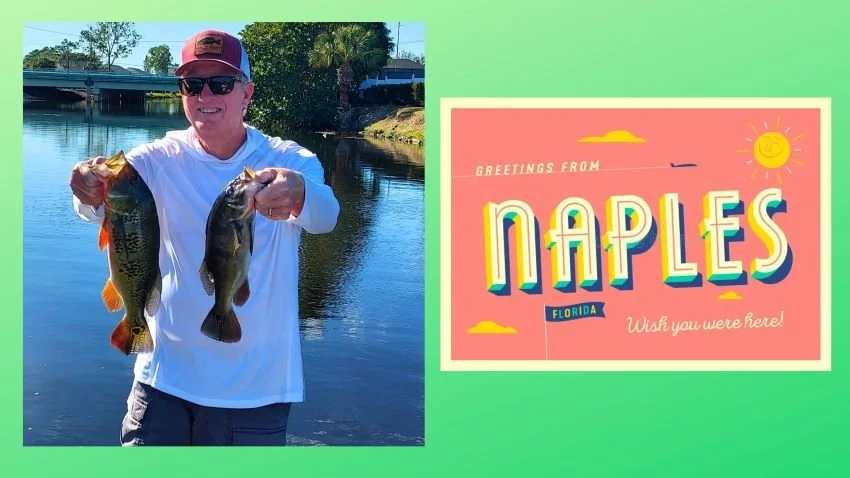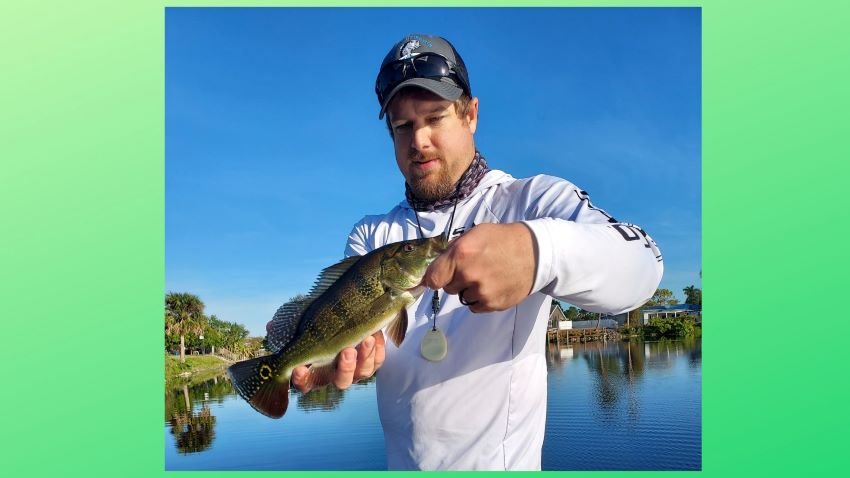Party with Peacocks in SW Florida
Monkeys screeched and scurried in the branches overhead as our boat eased through the narrow inlet to the mirror-surface jungle pond where the waters flooded cypress knees and fallen trees. A jaguar’s throaty purr caught my ears and raised the hairs on my neck in the misty dawn.
Such was the scene I’d long imagined based on the spine-tingling adventures of celebrity anglers on Amazon expeditions broadcast on TV shows and magazine stories. Ever since I first learned of the line-stripping, rod-snapping, hook-straightening power of South America’s peacock bass, they were high on my bucket list of fish I must catch before I make my final cast.
So there I was one recent Monday morning as Garrett Farmer guided his bass boat through a narrow canal. A great blue heron waded the shoreline ahead as the sun peeked over the suburban houses behind us. An osprey rode the morning thermal. A cat prowled the legs of lanai furniture, while dogs barked behind chain-link fences and Interstate 75 traffic rumbled over the bridge in the distance.
I was a guest of fisherman Farmer on my first quest for the butterfly peacock bass thriving in the canal systems of Southwest Florida. Stocked a generation ago in the waters around Miami International Airport, peacocks have expanded their range across the Everglades and now stake claims as apex predators in the freshwater lakes, ponds and canals that seep toward the Gulf of Mexico. They share the waters with largemouth bass, cichlids and the occasional snook and tarpon.
Farmer is among the growing number of Florida fishing guides who have learned the ins-and-outs of putting clients in touch with the spectacular peacock bass. We fished the network of cuts and ponds off the main Golden Gate Canal just east of the city of bustling Naples.
We launched just after daybreak but expected slow fishing until the sun climbed overhead to warm the waters that had chilled to 65 degrees following several days of cold-front weather and sub-50-degree nights. Native to the Amazon, Orinoco and other drainages of Brazil, Peru and Venezuela, peacocks are genetically inclined to be most active when their waters are closer to 80 degrees than 65.
Though Farmer knew we’d be more likely to connect with live shiners that chilly morning, we opted for artificial lures. He chose a buzzbait and jerkbait and I tied on a Pop-R and a 3-inch white boot-tail swimbait threaded on a ¼-ounce jighead. We started in a short passage connecting the main stem of the Golden Gate canal system to a 50-acre lake. It necked down to another arm of the canal system, which funnels water from the western edge of the Everglades toward the Gulf of Mexico.
We pitched our lures toward the shoreline cover and patches of hydrilla and scattered lily pads. Farmer struck first. A 15-inch peacock slashed his jerkbait as he twitched it through a hole in the hydrilla.
The preceding cold front left the peacocks mostly unwilling to eat our lure until around 10:30 when we started noticing groups of three to four rise to investigate our baits. Still a bit sluggish in the cool water, the peacocks appeared curious but not committed, save for a half-dozen that found the trebles.
Spectacular fighters, each of our peacocks were great fun on standard bass tackle and the perfect teaser fish for a return trip under more favorable temperatures.
Garrett and his brother Luke guide throughout southwest Florida, Luke working more in the abundant saltwater venues around Fort Myers. Garrett and others have zeroed in on the growing popularity of the exotically sporty peacocks, perfect for vacationing anglers seeking a half or full day on the water.
“I was impressed by the catching last summer in the canals off Alligator Alley (Interstate 75),” he said. “They love the warm days and the bite is strong during the spring spawn and through the summer until it gets cool in the fall.”
An experienced bass tournament angler, Farmer said peacocks react differently than largemouth bass. They are most active in the middle of the day and can be more aggressive than smallmouths.
For families and anglers who prefer live-bait fishing, Farmer brings 2- to 4-inch shiners. He has plenty of experience with catching peacocks on artificial lures and noted that when conditions are tough, he often goes opposite of the finesse tactics that work on largemouth bass. “Power fishing really works for peacocks, including the Alabama rig.”
In addition to peacocks and saltwater fishing, southwest Florida offers good crappie fishing. “Lake Trafford is a sleeper when the crappies are on,” he said. “Plus it has some big bass.”
Farmer said interest in SW Florida peacocks continues to grow. “We get everyone from beginners to tournament veterans, all the skill levels. I know 10 or 12 guides now who are working peacock trips.”
For peacocks and more, contact Farmer Fishing Charters, 239-898-2762 or garfish12@aol.com. If Garrett is unavailable, he’ll offer recommendations for other guides.







